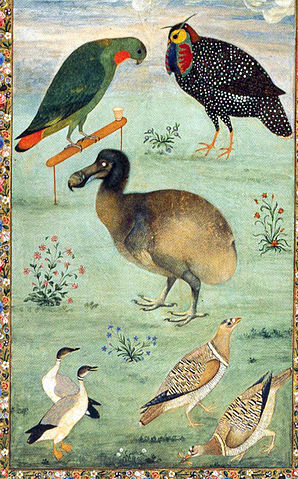 |
This is a file from the Wikimedia Commons. Information from its description page there is shown below.
Commons is a freely licensed media file repository. You can help.
|
Summary
| Description |
English: Painting by the Mughal artist Ustad Mansur from c 1625, which may be one of the most accurate depictions of a live dodo. Two live specimens were brought to India in the 1600s according to Peter Mundy, and the specimen depicted might have been one of these. Other birds depicted are Loriculus galgulus (upper left) Tragopan melanocephalus (upper right), Anser indicus (lower left) Pterocles indicus (lower right)
|
| Date |
17th century |
| Source |
Hermitage, St. Petersburg. http://julianhume.co.uk/wp-content/uploads/2010/07/History-of-the-dodo-Hume.pdf Earlier version: http://www.natuurinformatie.nl/nnm.dossiers/natuurdatabase.nl/i005387.html |
| Author |
Ustad Mansur |
Licensing
| Public domainPublic domainfalsefalse |
 |
This work is in the public domain in the United States, and those countries with a copyright term of life of the author plus 100 years or less. |
|
This file has been identified as being free of known restrictions under copyright law, including all related and neighboring rights.
|
File usage
The following pages on Schools Wikipedia link to this image (list may be incomplete):
This file contains additional information, probably added from the digital camera or scanner used to create or digitize it. If the file has been modified from its original state, some details may not fully reflect the modified file.
SOS Childrens Villages has brought Wikipedia to the classroom. SOS Childrens Villages is an international children's charity, providing a good home and loving family to thousands of children who have lost their parents. We also work with communities to help vulnerable families stay together and raise children in the best possible environment. Help another child by taking out a sponsorship


 →
→ 

